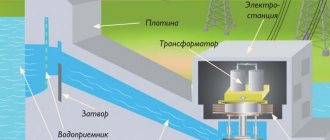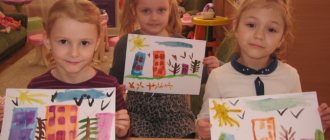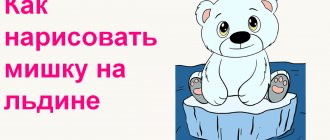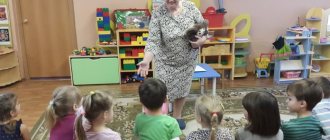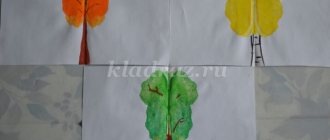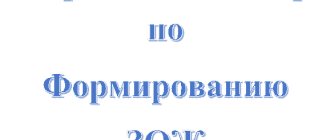Summary of GCD for the middle group of kindergarten on the topic: Sorceress water
Synopsis of educational activities directly.
Topic: “Visiting Princess Droplets” Educational area:
cognition
Integration of educational areas:
cognition, communication, socialization
Goal:
To develop in children knowledge about the importance of water in human life: - water is the source of life,
Educational objectives:
- To provide basic knowledge about the water cycle in nature
- Improve skills in conducting laboratory experiments
- Explain to children why water sometimes needs to be purified and give a basic understanding of the filtration process.
Educational tasks:
- Cultivate love for one's native land
- Instill respect for water.
Developmental tasks:
- Develop cognitive interest through the use of information and communication technologies
- ABOUT
enrich children's vocabulary with nouns, adjectives and verbs on the topic of GCD.
- Develop social skills: the ability to work in a group, negotiate, take into account the opinion of a partner.
Methodical techniques:
conversation
,
teacher's story, experimental activity, observation, musical accompaniment, physical education, individual work, group work, game technique, problem situation, poetry reading, multimedia presentation.
Types of children's activities:
cognitive-research, cognitive-search, problem solving, communicative, situational conversation, play, motor.
Preliminary work:
observation of icicles and frozen puddles on a walk, experimental activities - states of water, properties of water, outdoor games
Material for the lesson:
glass vessels according to the number of children, copper key, pieces of ice, thermos, saucer, water, jar of dirty water , reading jar, napkins, cotton wool, activated carbon, sand, aqua filter, funnel, multimedia presentation.
GCD progress: First part. organizational moment (children and teacher stand in a circle)
Teacher:
“Stand up children, stand in a circle, You are my friend and I am your friend, Let’s hold hands tightly, And smile at each other.”
Educator:
- Guys, today we were invited to visit, but do you know how to behave when visiting?
Children.-
Yes!
Educator
.- And how?
Children
.- You cannot touch other people’s things without permission, shout, play around, answer when asked, etc.
Educator
.- That’s right, well done, have you forgotten what to say when meeting and when leaving guests?
Children.-
No.
Educator
.- So what?
Children.
- Hello and goodbye.
Educator
.- That's right, what a great fellow you are, and now it's time for us to go on our way.
(Knock on the door) Educator
. - Oh, who came to us there?
(The teacher comes to the door and takes the envelope.) Educator
.- Guys, someone sent us a letter, it’s probably an invitation from Princess Droplet.
(Opens the envelope and tells the children with surprise that the evil sorceress has bewitched the princess.) Educator:
- Guys, what do you need to do, rescue the princess from evil spells.
Well, should we help her? Children:
- Yes!
Educator: -
Then let's go, but you need to choose the fastest transport.
Children choose transport. Educator .
Let's go on a fabulous transport.
Let these be our chairs. We will say the magic words, and our chairs will fly. Children say the magic words:
“One, two, three, my chair fly.” Children close their eyes, imitate the flight movements of the chair, and “land” in the kingdom of water.
Second part, main
On the screen there is a slide “the kingdom of water”, a gate with a large lock, a small note from below.
Educator.
- So we have arrived, but look what it is, there is a big lock on the door.
There's a note here. The teacher reads the note:
“If you want to get to the princess, you will need to find the key to the castle, which is located under these jars of water, but they cannot be moved until you find the key.”
Evil sorceress. Educator. -
Well, you’ll have to look for the key, just don’t forget that you can’t move the cans.
(the key can only be seen if you look at the top of the jar; it is invisible from the sides) Educator:
Well done, now we can open the lock and save the princess.
(They open the castle and enter the kingdom of water) Slide “Princess Droplet” Princess. -
Hello children.
Children: -
Hello.
Princess.-
Thank you for being able to free me from the evil spell of the sorceress.
My name is Droplet - I am a princess in the kingdom of water. An evil sorceress bewitched me because I did not tell her the secret of water. And I invited you to reveal the secret of water, because I need your help. What do you know about water? Educator:
We know a lot about water
. (I ask questions to the children) Educator:
-Guys, can you live without water
? Children: -
No, you can’t!
Educator: -
Who needs water for?
Children: -
Animals, birds, plants, fish, people need water.
Educator: -
That's right, why do we need water?
Children:
- Water is needed to drink, to wash;
- To clean, - To do laundry, - To cook food, - To water the plants. Educator: -
That's right, you can't do a single thing without water.
Where does water live? Children: -
Water lives in the sea, ocean, river, tap.
Educator
: - Where do you think the water in the tap comes from?
Children:
- It flows through the pipes from the river.
Educator: -
That's right, the water in the tap is river water.
The man directed the water through pipes, and it traveled a long way before it got to our house. Educator:
Do the guys know a poem about water, let's read it to the Princess?
Children: 1).Azalea
Have you heard about water?
They say she's everywhere! In a puddle, in the sea, in the ocean And in a water tap... 2) Sabina
Like an icicle, she freezes.
Fog creeps into our house. It’s called a glacier in the mountains, It curls like a silver ribbon And it’s called the Purdan River 3) Anya Shaikhutdinova
It’s boiling on your stove, The steam of the kettle hisses, It dissolves sugar in tea... We don’t notice it, We’re used to the fact that water is always our companion!
4) Arina Kanyukova
We can’t wash ourselves without her, we can’t eat, we can’t get drunk! I dare to report to you: We cannot live without water!
Educator:
And we also know how magical water can be.
( brings the children to the table, on which there are 2 glasses, one with water, a thermos with hot water, a plate, ice)
Look, liquid water can be poured from one dish to another.
But when it cools, the water becomes hard as stone. What do you think this is? -
It's ice.
Educator:
- That's right, look here it is ice, hard as stone, but when the ice melts, it turns into liquid again.
When heated, water turns into steam, look ( opens a thermos with hot water. Steam is visible)
Do you see steam?
Children: -
Yes!
Educator: -
And steam, guys, is also water.
( I take the glass, hold it over the steam, droplets of water form on the glass. I show it to the children
)
Educator: -
So we know that there are different types of water?
Children
: - Liquid!
Educator -
And if you freeze it, what does the water turn into?
Children: -
On the ice!
Educator -
And when heated?
Children
: - In pairs!
Princess:
Well done guys!
The time has come to reveal to you the secret of water, listen. (the story is accompanied by a video show)
Once I was floating on a cloud, I really liked riding on a cloud in the sky.
The clouds were as light as cotton wool. But suddenly a strong wind blew, thunder struck, lightning flashed and the clouds turned into black clouds. It began to rain on the ground. I, along with other droplets, flew down. I flew and had fun because I saw a lot of interesting things. I hit the roof of the house, jumped up and rolled with the rain down the drainpipe. All the droplets in this stream joined hands, there were more and more of us - and we turned into a stream, and the stream carried me and my friends into a big river. We enjoyed riding the waves with our friends, like on a boat. All summer and autumn, my friends and I traveled along the river, and did not notice how cold it was, winter came. And my friends and I turned into ice. I slept all winter, but in the spring the sun warmed the river with its rays, the ice melted and a ray of sunlight turned me into steam. And I began to rise to the sky, on the way I met my friends, droplets that evaporated from lakes, from soil, from plants - we held hands and we got light clouds. This process is called the water cycle in nature . Educator:
Let's look at the poster and remember how this happens.
Physical education minute
Educator:
And in order to remember well the secret of water, we will play with you. Come on, cloud, pour, pour. For the children, don’t be sorry. Let them turn into a droplet and have fun from the heart.
“I’m Mother Cloud, and you’re little kids, come here to me.” (music sounds, children jump, run, repeat the movements after the teacher, according to the teacher’s instructions, the children unite into streams of 2-3 children, then unite into a large river, run like a snake, the river flowed, flowed, cold weather set in, the frost bound the river, turned it into ice, spring has come, the sun melted the ice and the droplets returned to the mother cloud. They rose and flew to the cloud.)
The music died down, the children sat down.
Experimental activities
Educator
: Thank you Princess Droplet for revealing to us the secret of water.
But how can we help you? Princess Droplet ( the story is accompanied by a slide show )
Oh, trouble, trouble, trouble There’s dirty water everywhere, What should I do - help me, Save my inhabitants: The fish are dying here and there, They won’t find clean water anymore, Their fins are stuck together, How can they swim?
Please tell me, people are littering again. The fish have nothing to breathe and I can’t cope alone. I shed tears, I don’t sleep at night anymore. How to purify all the water? Educator -
How can we help you?
(The princess takes out a jar of dirty water, slide) Princess Droplet: -
Look how dirty the water is, can you drink this water?
Children:
- No, you can’t.
Princess Droplet:
“It’s so dirty everywhere, but this jar is not simple, it’s magical, and if the water in the jar is purified, it will become clean everywhere.”
But for this to happen, one condition must be met: all of you must purify the water; one person cannot cope with this. Educator
- Guys, let’s help the princess purify the water?
Children:
- Yes!
Educator:
- Then come here to this table.
Before we get started, let's stretch our “Drops”
. Hands are extended upward, palms forward.
A drop - one, a drop - two, The drops barely drip - Drip, drip, drip, drip. The droplets began to run, The droplet began to catch up with the droplet - Drip, drip, drip, drip. (they come to the table where there are glasses, for each child, a funnel, paper napkins, cotton wool, sand. I pour all the dirty water into glasses, insert a funnel into the jar, make a filter and be the first to show how to purify the water, and then the children repeat everything after me take turns) Educator:
Princess Droplet, look how we purified the water, do you like it?
Princess:
- Thank you, guys. For your kindness, because you saved not only the aquatic inhabitants, but also all life on earth, for this, guys, I want to give you a gift
RESULT:
Educator:
What did you guys like most about our trip?
What secret did Princess Droplet reveal to us? How did you and I help the princess and all living things on earth? What needs to be done to keep the water on earth clean? The teacher reads a poem about water. Water travels in nature. It never disappears, It will turn into snow, then into ice, It will melt and go hiking again! Along mountain peaks and wide valleys, suddenly it soars into the sky and turns into rain. Look around you, take a closer look at nature, you are surrounded everywhere and always - This sorceress of ours is water!
Lesson notes for the middle group “what do we know about water?”
Lesson summary for the middle group
“WHAT DO WE KNOW ABOUT WATER?”
Educator.
Target.
Introduce children to the properties of water (taste, color, smell, fluidity).
Tasks:
v Clarify its meaning for all living things.
v Develop children's curiosity, thinking and speech; introduce the following words into the children's active dictionary: liquid, colorless, tasteless, transparent.
v Foster respect for water.
Methods and techniques:
Gaming (introduction of a game character, surprise moments).
Visual (diagrams, symbols).
Practical (experiments)
Verbal (conversations, teacher’s story, search questions).
Preliminary work:
Production of panels of symbols and diagrams.
Reading stories and fairy tales of an educational nature.
Conversations on the topic: “Where you can find water”, “Who lives in water”.
Materials and equipment:
Equipment for experiments: glasses of water (according to the number of children), empty glasses, salt, sugar, brilliant green, potassium permanganate, spoons.
Symbols indicating the properties of water
Emblems “When you wash your hands, don’t forget to close the tap tightly.”
Dunno doll.
Progress of the lesson
Children enter the group and sit on chairs.
Teacher (with the toy Dunno): Guys, today I went to kindergarten and met Dunno. He sat so sad. I asked him what happened, and he told me that it turns out he doesn’t know anything about water. I reassured him and the guys and said that we could help him. Shall we help? (Children's answers). Dunno, sit down on a chair. Our guys still know a little about water, but together, I’m sure we’ll figure it out.
Q: Guys, what is water? (Children's answers).
Water is a liquid. It flows. It can be poured into anything: a glass, a bucket, a vase. It can be poured out, poured from one vessel to another.
Experiment No. 1 “Water is a liquid.”
Would you guys like to try pouring water from one glass to another? (Children's answers). Go to the tables and sit comfortably.
Conclusion:
Water is a liquid; it can be poured or poured. And for you. Guys, you too, Dunno, better remember this, I prepared this symbol (posted on the board).
Experiment No. 2 “Colorless water.”
Q: Guys, what color do you think the water is? (Children's answers). We'll check this now.
On the teacher’s table is a white sheet of paper, a glass of milk, a glass of water.
Q: What color is the milk? (white). Can you say about water that it is white? (Children's answers).
Conclusion:
water has no color, it is colorless (a symbol of this property is hung in front of the children)
Experiment No. 3 “Water changes color.”
V.: Guys, I know that water can change its color. Want to make sure of this? What do you want, Dunno? (Answers).
On the teacher’s table there are 2 glasses of water, brilliant green, and potassium permanganate. This experiment is carried out only by the teacher.
V.: I’ll now add a magic crystal (potassium permanganate) to the water and we’ll see what happens to the water. Has the water changed its color? Now I’ll add a magic drop (green stuff) to the water. Let's see what happens to the water. Has the water changed its color? (Children's answers).
Conclusion:
water can change color depending on what is added to it.
Q: Do you think the water will change its color if you add jam to it? Try this at home.
Now, I suggest you guys taste the water. (Children are offered boiled water). What is she like? Sweet? Salty? Bitter?
Conclusion:
water has no taste, it is tasteless.
And so that you guys don’t forget this and you, Dunno, so that you don’t forget, I have prepared for you a symbol of this property of water.
Experience No. 4
(Children are given bowls with salt or sugar, spoons).
V.: Let's do a little experiment with you. Place the substance that is on your table in a glass of water (the teacher demonstrates). Stir and now taste the water. What did it taste like? (Children's answers). What do you think you added to the water? (Children's answers).
Conclusion:
It turns out that water can take on the taste of the substance that was added to it.
Experiment No. 5 “Water has no smell.”
V.: And now, I suggest you guys smell the water. Does the water smell anything?
Conclusion:
The water does not smell of anything, it has no odor.
A symbol of this property of water is displayed.
V.: You and I learned, children, that water can change color and taste. Can she change her smell? How do you think? (Answers). Try this experiment at home, and tell all the children what happens.
V.: And now I suggest you guys go to the chairs. Sit down too, Dunno.
Today, guys, we talk a lot about water, we learned a lot about it. But let's tell Dunno what water is needed for and who needs it?
V.: Well done, guys! Well, Dunno, did you learn anything new about water?
Dunno: Yes! It's just so hard to remember.
V.: And the guys, Dunno, will remind you again. Listen and remember: (based on symbols):
v Water is a liquid, it can be poured, poured, poured out.
v Water is colorless.
v Water is tasteless.
v Water has no odor.
Dunno: Well. Thank you, Dunno, now I know everything about water.
Q: Do you know, Dunno, that you need to save water, and when you wash your hands, you need to immediately turn off the tap?
Dunno: Why take care of it? Look how much water!
V.: There is a lot of water, but only purified water is needed for washing and cooking. And to get clean water, people spend a lot of effort. That’s why you need to save water and close the tap tightly.
And so that you, Dunno, don’t forget about this, here’s a reminder for you - a reminder: “When you wash your hands, close the tap tightly.”
Dunno: Thank you guys, now I will never forget that the tap must always be closed tightly.
V.: Guys, let’s hang the same reminders in our washroom. Do you agree? (Answers). And now I have another surprise for you (colored droplets are added). What do you think this is? (Answers)
I will give these drops to everyone so that you always remember that you need to take care of the water.
For the section methodical piggy bank.
Get text
